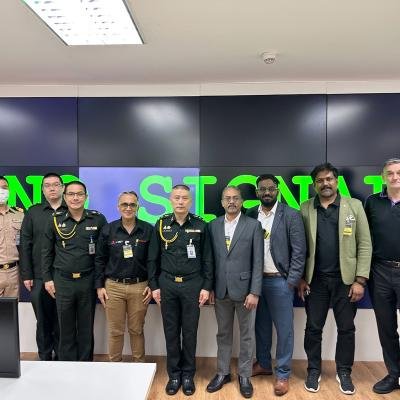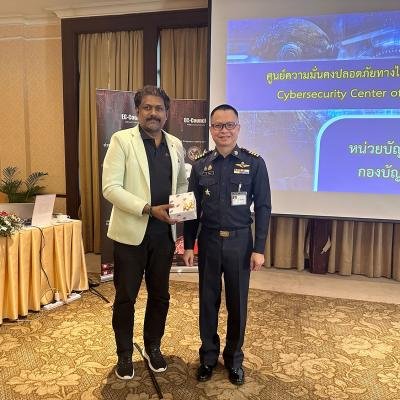In today's fast-paced and digitally driven world, the reliance on technology has become indispensable for businesses and individuals alike. However, this digital transformation has also given rise to a multitude of cyber threats, making cybersecurity a paramount concern for organizations. As technology advances, so does the sophistication of cybercriminals, leading to a constant battle between those seeking to exploit vulnerabilities and those committed to defending against these attacks.
The increasing frequency and severity of cyberattacks have demonstrated the need for a proactive and robust defense system. This is where Security Operations Centers (SOCs) play a crucial role in safeguarding the digital frontier. In this blog post, we will delve into the significance of SOC in today's world and explore how it acts as a shield against emerging cyber threats. From understanding the modern cyber threat landscape to the benefits and challenges of implementing a SOC, we will unravel the essential aspects of this pivotal cybersecurity component. Join us as we journey into the realm of SOC, where security, intelligence, and resilience converge to protect our digital way of life.
Understanding the Modern Cyber Threat Landscape:
The modern cyber threat landscape is a treacherous terrain, with cybercriminals continuously devising new and sophisticated ways to exploit vulnerabilities in digital systems. The rapid expansion of the internet and interconnected devices has provided ample opportunities for malicious actors to target individuals, organizations, and even nations. Understanding the different facets of this landscape is crucial for building effective defense strategies. Here are some key aspects of the contemporary cyber threat landscape:
- The Proliferation of Cybercrime: Cybercrime has evolved into a thriving underground economy, with cybercriminals operating as organized groups. They engage in a range of nefarious activities, such as data breaches, ransomware attacks, identity theft, and financial fraud. The financial gains from cybercrime are enormous, making it an enticing option for criminals worldwide.
- Advanced Persistent Threats (APTs): APTs are highly sophisticated and stealthy attacks, often sponsored by nation-states or advanced hacking groups. These threats are patient and persistent, aiming to infiltrate high-value targets like government agencies, critical infrastructure, and multinational corporations. APTs can remain undetected for extended periods, gathering sensitive information or causing significant damage.
- Insider Threats: Insider threats pose a unique challenge, as they originate from within an organization. Employees, contractors, or business partners with access to sensitive information can deliberately or inadvertently cause harm. Insider threats can result from negligence, malicious intent, or social engineering tactics.
- Ransomware and Extortion: Ransomware attacks have become increasingly prevalent, targeting individuals, businesses, and even public institutions. These attacks encrypt victims' data, rendering it inaccessible until a ransom is paid to the attackers. Ransomware can disrupt critical services, leading to significant financial losses and reputational damage.
- Phishing and Social Engineering: Phishing remains a common tactic for cybercriminals to gain unauthorized access to accounts and sensitive information. Social engineering techniques, such as pretexting, baiting, and tailgating, exploit human psychology to manipulate individuals into revealing confidential information.
- Supply Chain Attacks: Cyber attackers often target the supply chain to infiltrate organizations indirectly. By compromising suppliers or vendors, malicious actors can gain access to the target organization's network and data.
- Internet of Things (IoT) Vulnerabilities: The rapid proliferation of IoT devices has expanded the attack surface for cybercriminals. Insecurely configured IoT devices can be exploited to launch large-scale attacks, creating botnets and causing massive disruptions.
- Nation-State Cyber Warfare: Nation-states engage in cyber warfare, seeking to disrupt critical infrastructure, steal sensitive information, and conduct espionage. These attacks can have far-reaching geopolitical consequences.
- Zero-Day Vulnerabilities: Zero-day vulnerabilities are software flaws unknown to the vendor and, thus, lack available patches. Cyber attackers exploit these vulnerabilities before developers can issue fixes, making them particularly dangerous.
The Role of SOC in Cybersecurity:
The Security Operations Center (SOC) plays a pivotal role in the realm of cybersecurity, serving as a central nerve center for an organization's defense against cyber threats. As the cyber landscape becomes increasingly complex and the sophistication of attacks rises, SOC teams are at the forefront of protecting digital assets and sensitive information. Here are the key roles that SOC fulfills in cybersecurity:
- Proactive Threat Detection: SOC teams are equipped with advanced security tools and technologies that enable them to monitor networks, systems, and endpoints in real-time. By analyzing security logs, events, and network traffic patterns, SOC analysts can swiftly detect potential threats, anomalies, and suspicious activities.
- Incident Response and Management: When a security incident occurs, time is of the essence. SOC teams are trained to respond promptly and effectively to contain and mitigate the impact of security breaches. They follow well-defined incident response protocols to minimize damage and restore normal operations as quickly as possible.
- Continuous Monitoring: Cyber threats do not adhere to regular working hours. SOC operations run 24/7, providing continuous surveillance to ensure that any signs of compromise or unusual activities are identified immediately. This constant vigilance allows for rapid responses to emerging threats.
- Threat Intelligence and Analysis: SOC analysts continuously collect, analyze, and interpret threat intelligence from various sources. By staying up-to-date on the latest cyber threats and attack techniques, SOC teams can anticipate potential risks and prepare appropriate defenses.
- Security Tools Management: SOC manages and maintains a wide array of security technologies, including firewalls, intrusion detection systems (IDS), intrusion prevention systems (IPS), antivirus software, and SIEM (Security Information and Event Management) solutions. They ensure that these tools are properly configured and updated to enhance the organization's security posture.
- Vulnerability Management: SOC teams conduct regular vulnerability assessments and penetration testing to identify weaknesses in the organization's infrastructure and applications. This enables proactive measures to address vulnerabilities before they are exploited by malicious actors.
- Threat Hunting: In addition to passive monitoring, SOC analysts engage in proactive threat hunting. They actively search for indicators of compromise and potential security breaches that may have gone undetected by automated systems.
- Compliance and Regulations: SOC plays a critical role in ensuring that the organization adheres to industry-specific compliance requirements and regulations related to data protection and privacy. This includes handling and reporting security incidents in compliance with relevant laws and regulations.
- Collaboration and Knowledge Sharing: SOC collaborates closely with other teams within the organization, such as IT, legal, and human resources, to enhance incident response capabilities and information sharing. Cross-departmental cooperation is essential for a comprehensive and effective cybersecurity strategy.
By fulfilling these vital roles, SOC acts as a proactive shield against cyber threats, ensuring that organizations can defend against existing and emerging risks. The SOC's ability to detect, respond, and adapt to evolving threats empowers organizations to protect their digital assets, maintain business continuity, and instill confidence in their stakeholders. In the dynamic and ever-changing cyber landscape, the SOC remains an indispensable component of a robust cybersecurity defense strategy.
Benefits of Implementing a SOC:
Implementing a Security Operations Center (SOC) offers numerous benefits for organizations seeking to strengthen their cybersecurity posture and protect their digital assets. Let's explore the key advantages of implementing a SOC:
- Enhanced Incident Response Capabilities: A SOC provides a dedicated team of cybersecurity professionals who are trained to respond swiftly and effectively to security incidents. Their expertise and experience in incident response enable organizations to contain and mitigate threats more efficiently, minimizing the potential damage and reducing the time taken to restore normal operations.
- Reduced Downtime and Business Impact: With a SOC in place, organizations can detect and respond to security incidents promptly. By minimizing the time between identifying an incident and taking appropriate action, SOC teams help reduce downtime and its associated costs. This ensures that business operations can continue smoothly, preventing significant financial losses and reputational damage.
- Improved Threat Visibility: SOC operations provide comprehensive visibility into an organization's security posture. By monitoring networks, systems, and endpoints in real-time, SOC analysts can detect potential threats, vulnerabilities, or unauthorized activities. This enhanced visibility allows organizations to proactively manage risks, make informed decisions, and implement the necessary security controls to protect their assets effectively.
- Increased Customer Trust and Reputation: Implementing a SOC demonstrates an organization's commitment to cybersecurity and safeguarding sensitive information. This commitment enhances customer trust, as clients and partners gain confidence that their data is being protected. The reputation of the organization is also strengthened, as it is perceived as being proactive and responsible in the face of evolving cyber threats.
- Access to Threat Intelligence and Analysis: SOC teams actively collect, analyze, and interpret threat intelligence from various sources. This includes monitoring global cybersecurity trends, emerging attack vectors, and threat actor behaviors. By leveraging this intelligence, organizations gain valuable insights into potential risks and can proactively adjust their security measures to counteract evolving threats.
- Compliance and Regulatory Support: SOC plays a critical role in helping organizations meet industry-specific compliance requirements and regulations. By continuously monitoring and analyzing security events, SOC teams assist in maintaining compliance with data protection, privacy, and cybersecurity regulations. This ensures that organizations avoid penalties and legal consequences associated with non-compliance.
- Scalability and Flexibility: SOC services can be tailored to meet the specific needs and budget of organizations. Whether organizations choose to establish an in-house SOC or outsource to a managed security service provider (MSSP), the flexibility allows them to scale their cybersecurity capabilities as their business grows and adapt to evolving threat landscapes.
Challenges and Considerations in Implementing a SOC:
While implementing a Security Operations Center (SOC) can offer significant benefits, there are several challenges and considerations that organizations should be aware of. These challenges include:
- Shortage of Skilled Professionals: One of the key challenges in implementing a SOC is the shortage of highly skilled cybersecurity professionals. The demand for experienced analysts, incident responders, and threat hunters often exceeds the available supply, making it difficult for organizations to build and maintain an in-house SOC. Recruiting and retaining qualified personnel can be a significant challenge.
- Resource Allocation: Establishing and operating a SOC requires a significant investment in terms of personnel, technology, and infrastructure. It is essential to allocate sufficient resources to build a robust SOC that can effectively monitor, detect, and respond to security incidents. Organizations must consider the cost implications and ensure they have the budget to support ongoing SOC operations.
- Complexity and Integration: SOC implementation involves integrating various security technologies, such as SIEM solutions, threat intelligence platforms, and incident response tools. Ensuring seamless integration and compatibility among these different systems can be complex and time-consuming. Organizations should carefully plan and design their SOC architecture to optimize efficiency and effectiveness.
- Continuous Training and Skills Development: The cybersecurity landscape is ever-evolving, with new threats and attack techniques emerging regularly. SOC personnel need to undergo continuous training and skills development to stay up-to-date with the latest trends, technologies, and best practices. Organizations should invest in ongoing training programs to ensure that SOC analysts have the necessary knowledge and skills to effectively respond to evolving threats.
- Collaboration and Communication: Effective collaboration and communication between SOC teams and other departments within the organization are crucial for seamless incident response and information sharing. Organizations should establish clear channels of communication, define roles and responsibilities, and foster a culture of cooperation across teams. Lack of collaboration can lead to delays in incident response and hinder the effectiveness of the SOC.
- Compliance and Legal Considerations: Organizations operating in specific industries or geographical regions must comply with industry-specific compliance requirements and data protection regulations. Implementing a SOC involves ensuring compliance with relevant laws and regulations, such as data privacy laws, breach notification requirements, and industry-specific security standards. Organizations must carefully consider the legal and compliance implications when establishing a SOC.
- Third-Party Risks: Organizations that choose to outsource SOC services to a managed security service provider (MSSP) must carefully evaluate the security and reliability of the chosen provider. Due diligence is required to ensure that the MSSP has the necessary expertise, experience, and infrastructure to deliver effective SOC services without compromising the organization's security.
Examples and Evidence:
- Increased Incident Detection and Response: According to the 2021 Cost of Cybercrime study by Accenture, organizations with a mature SOC detected and contained cyberattacks 23% faster compared to those without a SOC. This demonstrates the significant impact of a SOC in reducing the time taken to identify and respond to security incidents, minimizing the potential damage and mitigating financial losses.
- Mitigation of Advanced Threats: A case study by the SANS Institute highlighted how a healthcare organization successfully defended against an advanced persistent threat (APT) by leveraging their SOC capabilities. The SOC's continuous monitoring and threat hunting techniques allowed them to detect and respond to the APT, preventing the exfiltration of sensitive patient data and avoiding potential regulatory penalties.
- Proactive Threat Intelligence: SOC teams leverage threat intelligence to stay ahead of evolving cyber threats. For example, Cisco's 2021 CISO Benchmark Report found that organizations with a SOC that incorporates threat intelligence have a higher capability to proactively identify and respond to emerging threats. This proactive approach helps organizations stay one step ahead of cybercriminals and strengthen their security posture.
- Compliance and Regulatory Requirements: Implementing a SOC can help organizations meet compliance requirements and industry-specific regulations. For instance, the Payment Card Industry Data Security Standard (PCI DSS) mandates continuous monitoring and real-time threat detection, which aligns with SOC capabilities. By having a SOC in place, organizations can demonstrate their commitment to compliance and protect customer data, avoiding penalties and legal consequences.
- Improved Incident Response Time and Downtime Reduction: Verizon's 2021 Data Breach Investigations Report revealed that organizations with a SOC experienced a 48% faster response time to security incidents compared to those without a SOC. This faster incident response enables organizations to contain threats promptly, reducing the duration of security breaches and minimizing the associated downtime and financial impact.
- Cost Savings: While implementing a SOC requires an initial investment, it can result in long-term cost savings. The Ponemon Institute's 2020 Cost of Cybersecurity Breach study reported that organizations with a SOC experienced an average cost savings of $2.6 million compared to those without a SOC. This cost reduction is attributed to the SOC's ability to detect and respond to security incidents more efficiently, limiting the financial impact of breaches.
Conclusion:
In conclusion, the implementation of a Security Operations Center (SOC) is a critical step for organizations seeking to strengthen their cybersecurity defenses in today's rapidly evolving threat landscape. By establishing a SOC, organizations can benefit from enhanced incident response capabilities, reduced downtime and business impact, improved threat visibility, and increased customer trust. SOC teams provide round-the-clock monitoring, proactive threat detection, and swift incident response, mitigating the risks posed by cyber threats and helping organizations maintain their digital resilience.
However, organizations must also be mindful of the challenges and considerations that come with implementing a SOC. These include the shortage of skilled professionals, resource allocation, complexity of integration, continuous training, collaboration, compliance, and third-party risks. By addressing these challenges effectively, organizations can maximize the value and effectiveness of their SOC, ensuring that it operates seamlessly and contributes to their overall cybersecurity strategy.
As an organization, digiALERT understands the importance of a SOC in today's world. By carefully considering the benefits, challenges, and considerations associated with implementing a SOC, digiALERT can help organizations navigate the complexities of cybersecurity and build a robust defense against evolving cyber threats. With our expertise in SOC implementation, we are committed to empowering organizations to protect their digital assets, maintain business continuity, and stay one step ahead of malicious actors in the ever-changing digital landscape.
In this digital age, where the stakes of cyber threats are high, digiALERT is here to provide the necessary support and expertise to organizations as they strive to safeguard their digital way of life. Together, let's fortify our defenses, detect and respond to threats, and build a resilient cybersecurity ecosystem that enables us to embrace the benefits of technology while minimizing the risks. Stay alert, stay secure with digiALERT.







